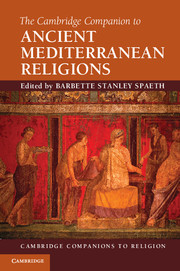Refine search
Actions for selected content:
23990 results in Ancient history

The Cambridge Companion to Ancient Mediterranean Religions
-
- Published online:
- 05 December 2013
- Print publication:
- 25 November 2013
PART II - TEXTS AND TRANSLATIONS
-
- Book:
- Themistius, Julian, and Greek Political Theory under Rome
- Published online:
- 05 December 2013
- Print publication:
- 28 November 2013, pp 123-123
-
- Chapter
- Export citation
3 - Themistius, Julian, and Julian's Letter to Themistius
- from PART I - STUDIES
-
- Book:
- Themistius, Julian, and Greek Political Theory under Rome
- Published online:
- 05 December 2013
- Print publication:
- 28 November 2013, pp 53-91
-
- Chapter
- Export citation
Letter of Aristotle to Alexander
- from PART II - TEXTS AND TRANSLATIONS
-
- Book:
- Themistius, Julian, and Greek Political Theory under Rome
- Published online:
- 05 December 2013
- Print publication:
- 28 November 2013, pp 180-207
-
- Chapter
- Export citation
Bibliography
-
- Book:
- Themistius, Julian, and Greek Political Theory under Rome
- Published online:
- 05 December 2013
- Print publication:
- 28 November 2013, pp 208-218
-
- Chapter
- Export citation
Introduction
-
- Book:
- Themistius, Julian, and Greek Political Theory under Rome
- Published online:
- 05 December 2013
- Print publication:
- 28 November 2013, pp 1-10
-
- Chapter
- Export citation
PART I - STUDIES
-
- Book:
- Themistius, Julian, and Greek Political Theory under Rome
- Published online:
- 05 December 2013
- Print publication:
- 28 November 2013, pp 11-12
-
- Chapter
- Export citation
4 - Epilogue
- from PART I - STUDIES
-
- Book:
- Themistius, Julian, and Greek Political Theory under Rome
- Published online:
- 05 December 2013
- Print publication:
- 28 November 2013, pp 92-107
-
- Chapter
- Export citation
Julian, Letter to Themistius
- from PART II - TEXTS AND TRANSLATIONS
-
- Book:
- Themistius, Julian, and Greek Political Theory under Rome
- Published online:
- 05 December 2013
- Print publication:
- 28 November 2013, pp 160-179
-
- Chapter
- Export citation
Frontmatter
-
- Book:
- Themistius, Julian, and Greek Political Theory under Rome
- Published online:
- 05 December 2013
- Print publication:
- 28 November 2013, pp i-iv
-
- Chapter
- Export citation
Appendix: Letter of Aristotle to Alexander
- from PART I - STUDIES
-
- Book:
- Themistius, Julian, and Greek Political Theory under Rome
- Published online:
- 05 December 2013
- Print publication:
- 28 November 2013, pp 108-122
-
- Chapter
- Export citation
Contents
-
- Book:
- Themistius, Julian, and Greek Political Theory under Rome
- Published online:
- 05 December 2013
- Print publication:
- 28 November 2013, pp v-v
-
- Chapter
- Export citation
Acknowledgements
-
- Book:
- Themistius, Julian, and Greek Political Theory under Rome
- Published online:
- 05 December 2013
- Print publication:
- 28 November 2013, pp vi-vi
-
- Chapter
- Export citation
1 - The political letter: Sopater, Letter to Himerius
- from PART I - STUDIES
-
- Book:
- Themistius, Julian, and Greek Political Theory under Rome
- Published online:
- 05 December 2013
- Print publication:
- 28 November 2013, pp 13-21
-
- Chapter
- Export citation
Themistius, Letter to Julian
- from PART II - TEXTS AND TRANSLATIONS
-
- Book:
- Themistius, Julian, and Greek Political Theory under Rome
- Published online:
- 05 December 2013
- Print publication:
- 28 November 2013, pp 132-159
-
- Chapter
- Export citation
Index of modern authors
-
- Book:
- Themistius, Julian, and Greek Political Theory under Rome
- Published online:
- 05 December 2013
- Print publication:
- 28 November 2013, pp 219-219
-
- Chapter
- Export citation
General index
-
- Book:
- Themistius, Julian, and Greek Political Theory under Rome
- Published online:
- 05 December 2013
- Print publication:
- 28 November 2013, pp 220-224
-
- Chapter
- Export citation
Sopater, Letter to Himerius
- from PART II - TEXTS AND TRANSLATIONS
-
- Book:
- Themistius, Julian, and Greek Political Theory under Rome
- Published online:
- 05 December 2013
- Print publication:
- 28 November 2013, pp 124-131
-
- Chapter
- Export citation
2 - Themistius, Letter to Julian
- from PART I - STUDIES
-
- Book:
- Themistius, Julian, and Greek Political Theory under Rome
- Published online:
- 05 December 2013
- Print publication:
- 28 November 2013, pp 22-52
-
- Chapter
- Export citation
Part II
-
- Book:
- The Cambridge Companion to Ancient Mediterranean Religions
- Published online:
- 05 December 2013
- Print publication:
- 25 November 2013, pp 197-344
-
- Chapter
- Export citation
